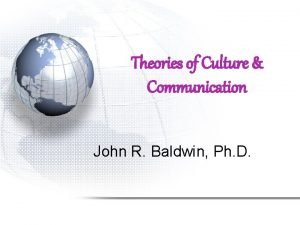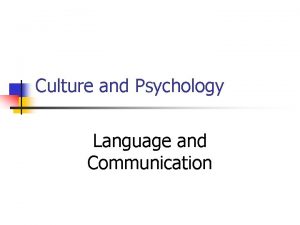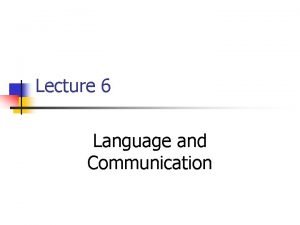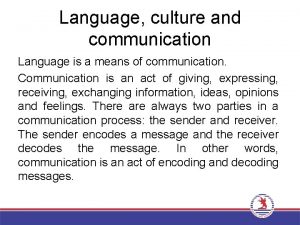Culture Language and Communication Part Two Culture and
























- Slides: 24

Culture, Language, and Communication Part Two

Culture and Social Cognition § This has to do with how we interpret the actions of others—the causal attributions we make. § Basically, the cultural differences in this area refer to proneness to make dispositional versus situational attributions of others behavior.

Definition of communication § Message: Information and meaning exchanged during communication § Encoding: Process by which people select, imbed messages in signals, and send signals to others § Signals: Specific verbal language and nonverbal behaviors that are encoded when message sent § Channels: Sensory modalities by which signals sent and messages retrieved § Decoding: Process by which people receives signal from encoder and translates those signals to meaningful messages

Intercultural Communication § Unlike intra-cultural communication where message senders and receivers share the same ground rules, intercultural communication is associated with a host of additional social and psychological issues.

Uncertainty § To start, there is uncertainty or ambiguity concerning the ground rules by which the interaction should occur. § Given the pervasive influence of culture, it’s always difficult to figure out the rules being employed by two people from different cultures. § And this uncertainty is inherent in verbal as well as nonverbal communication, in both encoding and decoding modes.

Uncertainty (cont. ) § How can we package messages into precise words to convey our thoughts as accurately as possible and how can we interpret the sender’s messages exactly as intended? § Uncertainty can easily mount to the point of utter miscommunication. Hence, uncertainty reduction is the initial major goal of intercultural communication. § Unless uncertainty is reduced, it’s impossible for senders and receivers to begin processing the intended message content.

Conflict § Once we engage in intercultural communication, some conflict and misunderstanding is inevitable. § Conflict arises when people’s behavior does not confirm to our expectations. § We tend to interpret such behaviors as transgressions against our values. § Of course, uncertainty can contribute to this conflict.

Context § As we have said earlier, context has to do primarily with how communication takes place when cultures vary in context orientation. Here are several possible combinations. § 1. High Context with High Context § 2. Low Context with High Context § 3. Low Context with Low Context

Context (cont. ) § But the “context of intercultural communication” also includes several other dimensions of cultural variability: § Individualism-collectivism, § Power Distance, § Uncertainty Avoidance, and § Masculinity-femininity

CULTURAL INFLUENCES ON NONVERBAL COMMUNICATION

§ Nonverbal behaviors: all behaviors that occur during communication that do not include verbal language § Nonverbal channels are more important in understanding meaning and emotional states of speakers than verbal language § It is imperative to be most attentive to nonverbal cues that occur in communication

The Types of Nonverbal Behaviors § Culture and Gestures § The American A-OK sign is an obscene gestures in may cultures of Europe § Culture and Gaze § Contact cultures engage in more gazing and more direct orientation when interacting with others § Culture and Interpersonal Space § Arabs and Latin Americans interact with others at closer distance than Americans

The Functions of Nonverbal Behaviors § Always keep in mind that Nonverbal behaviors serve as emblems, speech illustrators, conversation regulators, and convey emotions.

INTRACULTURAL AND INTERCULTURAL COMMUNICATION

§ Cultural Influences on Encoding § Cultures differ in how nonverbal behavior is used in communication § Cultural Influences on Decoding § Cultures influences decoding process through ethnocentrism, cultural filters, emotions, value judgments, stereotypes and expectations § Decoding rules

Intracultural communication § Communication between people of the same cultural background § Interactants share same ground rules; they encode and decode using the same cultural codes § Can be negative because of expectations created by cultural filters and ethnocentrism § We tend to read more than is intended

Intercultural communication § Communication between people of the different cultural background § Interactants do not share same ground rules; they encode and decode using different cultural codes § Can lead to § § Uncertainty and ambiguity Conflict

Barriers to Effective Intercultural communication 1. Assumptions of similarities 2. Language differences 3. Nonverbal misinterpretations 4. Preconceptions and stereotypes 5. Tendency to evaluate 6. High anxiety or tension

Barriers to Intercultural Communication § Source: Barna, L. M. (1997). Stumbling blocks in intercultural communication. In L. Samovar and R. Porter (Eds. ), Intercultural communication: A reader (pp. 370 -379). Belmont CA: Wadsworth.

Barriers (cont. ) 1. Assumptions of similarities § § We need to keep in mind that communication is a uniquely human trait shaped by culture. In fact, communication itself is a product of culture, and cultures vary in their assumptions of similarities.

Barriers (cont. ) 2. Language differences § § The use of words which may be highly effective at conveying meaning within a particular culture often communicate unintended meanings across cultures. Add to this the nonverbal channel of communication and you have a recipe for conflict and misunderstandings.

Barriers (cont. ) 3. Nonverbal misinterpretations § This is the single most frequent cause of breakdowns in the communication process across cultures. 4. Preconceptions and stereotypes § These are natural and inevitable psychological processes that have a strong influence on our perceptions and communications.

Barriers (cont. ) 5. Tendency to evaluate § We make attributions about the behavior of others based on our own cultural values. 6. High anxiety or tension § While some degree of anxiety may be conducive to optimal performance, too much anxiety or stress can lead to dysfunctional thought processes and behaviors.

Improving Intercultural Communication: Concluding Remarks § Mindfulness and uncertainty reduction § § Mindfulness offsets uncertainty and anxiety Uncertainty reduction leads to focus on the content of signals and messages § Face § Should be mindful of face (public appearance of person) in collectivist culture § Emotion Regulation § Controlling negative emotions aroused from conflict is important
 Part whole model subtraction
Part whole model subtraction Unit ratio definition
Unit ratio definition Brainpop ratios
Brainpop ratios What is technical description
What is technical description Part bar
Part bar The phase of the moon you see depends on ______.
The phase of the moon you see depends on ______. Two way anova minitab 17
Two way anova minitab 17 Popular culture examples
Popular culture examples Continuous culture and batch culture
Continuous culture and batch culture American vs indian culture
American vs indian culture Stab and stroke culture
Stab and stroke culture Folk culture and popular culture venn diagram
Folk culture and popular culture venn diagram Examples of mass culture
Examples of mass culture Anaerobic media
Anaerobic media Homework due today
Homework due today Anaerobic culture method
Anaerobic culture method Robertson cooked meat medium
Robertson cooked meat medium Surface culture deep culture and esol
Surface culture deep culture and esol The diagram shows a hexagon abcdef
The diagram shows a hexagon abcdef 2. part two—analyzing the effect of transactions
2. part two—analyzing the effect of transactions Georgetown university communication culture and technology
Georgetown university communication culture and technology What is the study of communication, gender and culture
What is the study of communication, gender and culture Business communication - culture and ethics
Business communication - culture and ethics Theories of culture and communication
Theories of culture and communication Georgetown university cct
Georgetown university cct















































